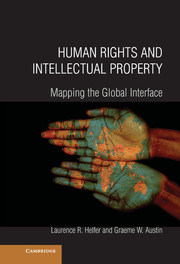Book contents
- Frontmatter
- Contents
- Preface
- 1 Mapping the Interface of Human Rights and Intellectual Property
- 2 The Human Right to Health, Access to Patented Medicines, and the Restructuring of Global Innovation Policy
- 3 Creators' Rights as Human Rights and the Human Right of Property
- 4 Rights to Freedom of Expression, to Cultural Participation, and to Benefit from Scientific Advancements
- 5 The Right to Education and Copyright in Learning Materials
- 6 The Human Right to Food, Plant Genetic Resources, and Intellectual Property
- 7 Indigenous Peoples' Rights and Intellectual Property
- 8 Conclusion
- References
- Acknowledgments
- Index
- Cases Discussed (Selected)
1 - Mapping the Interface of Human Rights and Intellectual Property
Published online by Cambridge University Press: 05 June 2012
- Frontmatter
- Contents
- Preface
- 1 Mapping the Interface of Human Rights and Intellectual Property
- 2 The Human Right to Health, Access to Patented Medicines, and the Restructuring of Global Innovation Policy
- 3 Creators' Rights as Human Rights and the Human Right of Property
- 4 Rights to Freedom of Expression, to Cultural Participation, and to Benefit from Scientific Advancements
- 5 The Right to Education and Copyright in Learning Materials
- 6 The Human Right to Food, Plant Genetic Resources, and Intellectual Property
- 7 Indigenous Peoples' Rights and Intellectual Property
- 8 Conclusion
- References
- Acknowledgments
- Index
- Cases Discussed (Selected)
Summary
Thematic Overview and Introduction
This book explores the relationship between human rights and intellectual property. Long ignored by both the human rights and intellectual property communities, the relationship between these two fields has now captured the attention of government officials, judges, activist communities, and scholars in domestic legal systems and in international venues such as the World Intellectual Property Organization, the United Nations Human Rights Council, the Committee on Economic, Social and Cultural Rights, the World Trade Organization, the World Health Organization, and the Food and Agriculture Organization. Widespread recognition of the relationship between human rights and intellectual property has a relatively recent vintage. Little more than a decade ago, few observers acknowledged the existence of such a relationship or viewed it as more than marginally relevant to the important issues and debates in each field. For participants in the human rights movement, the 1990s was a heady and hopeful period. In rapid succession, the world experienced the end of the Cold War, the birth of new democracies, the widespread ratification of human rights treaties, and the use of U.N.-sanctioned military force in response to widespread atrocities. These events, coming in quick succession after decades of political conflict, seemed to herald an “age of rights” and an “era of humanitarian intervention.” For the international intellectual property system, the 1990s was a time of rapidly expanding rules and institutions.
- Type
- Chapter
- Information
- Human Rights and Intellectual PropertyMapping the Global Interface, pp. 1 - 89Publisher: Cambridge University PressPrint publication year: 2011
- 1
- Cited by



